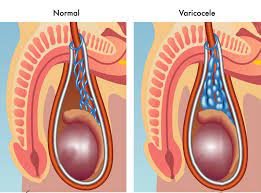
Varicocele
Varicocele, or enlarged veins in the scrotum, can cause oxidative stress, disrupt proper blood flow to the testes, or lower testosterone production — all of which can have a negative impact on sperm count. Varicocele usually appears during puberty and often goes unnoticed because the symptoms are usually mild.
A varicocele is most commonly found on the left side of the scrotum and often causes no symptoms. Among the possible signs and symptoms are:
- Standing or late in the day are more likely to cause a dull, aching pain or discomfort. Pain is frequently relieved by lying down.
- A mass in the scrotum. If the varicocele is large enough, a mass resembling a "bag of worms" may be visible above the testicle. A smaller varicocele may be too small to see but detectable by touch.
- A varicocele can make fathering a child difficult.
Diagnosis
Some common diagnostic tests include:
- A scrotal ultrasound test: Ultrasound creates a picture of what's inside your body by using sound waves.
- Varicoceles are veins larger than 3 millimeters in diameter with blood flowing in the wrong direction during the Valsalva maneuver can be determined.
- The size of the testicles can also be determined using ultrasound. This is helpful in determining how to treat teenagers.
If no problems are felt during the physical exam, an ultrasound is not required.
Treatment
Often, varicoceles are not treated. Treatment is offered for males who have:
- Fertility problems (problems fathering a child)
- The left testicle growing more slowly than the right
- Abnormal semen analysis
There are no drugs to treat or prevent varicoceles. However, pain relievers (such as acetaminophen or ibuprofen) may be beneficial.
When needed, surgery is the main form of treatment. Embolization (brief vein blockage) is a non-surgical treatment option.
Two approaches are commonly used today. The procedures include:
- Microscopic varicocelectomy. The surgeon makes a tiny incision low in the groin. The surgeon uses a powerful microscope to identify and ligate several small veins.
- Laparoscopic varicocelectomy. The surgeon performs the procedure using a video camera and surgical tools attached to tubes that pass through a few very small incisions in the lower abdomen.
Embolization: In this procedure, a vein is blocked by essentially creating a tiny dam. A radiologist inserts a tiny tube into a vein in your groin or neck. The radiologist releases coils or a solution that causes scarring to create a blockage in the testicular veins.
Make an appointment right away for consultation on your andrological issue.
Call With Doctor